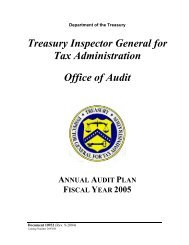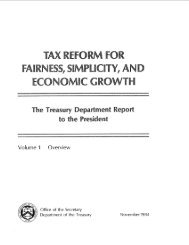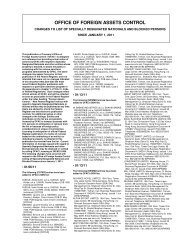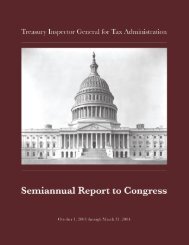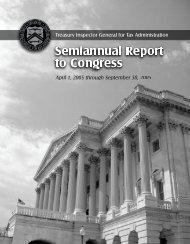Tax Reform for Fairness, Simplicity and Economic Growth
Tax Reform for Fairness, Simplicity and Economic Growth
Tax Reform for Fairness, Simplicity and Economic Growth
Create successful ePaper yourself
Turn your PDF publications into a flip-book with our unique Google optimized e-Paper software.
Volume I<br />
Overview<br />
Office of the Secretary <br />
Department of the Treasury<br />
November 1984
THESECRETARYOFTHETREASURY<br />
WASHINGTON DC 20220<br />
November 27, 1984<br />
Dear Mr. President: <br />
I am pleased to submit the Treasury Department's Report<br />
on Fundamental <strong>Tax</strong> Simplification <strong>and</strong> <strong>Re<strong>for</strong>m</strong> that you<br />
requested in your State of the Union address in January. It<br />
contains proposals <strong>for</strong> a broad-based income tax that would<br />
allow us to lower marginal tax rates <strong>for</strong> individuals by an<br />
average of 20 percent <strong>and</strong> the corporate rate from 46 percent<br />
to 33 percent. The proposals would make the tax system<br />
simpler, fairer, <strong>and</strong> more economically efficient.<br />
The present U.S. income tax is complex, it is <br />
inequitable, <strong>and</strong> it interferes with economic choices of <br />
households <strong>and</strong> businesses. It is also widely perceived to <br />
be unfair. Because this perception undermines taxpayer<br />
morale, it may be as important as the actual defects of the <br />
system. <br />
In your State of the Union address, you said: <br />
"To talk of meeting the present situation by increasing <br />
taxes is a B<strong>and</strong>-Aid solution which does nothing to cure <br />
an illness that has been coming on <strong>for</strong> half a century, <br />
to say nothing of the fact that it poses a real threat <br />
to economic recovery.... <br />
There is a better way: Let us go <strong>for</strong>ward with an<br />
historic re<strong>for</strong>m <strong>for</strong> fairness, simplicity <strong>and</strong> incentives<br />
<strong>for</strong> growth. I am asking Secretary Don Regan <strong>for</strong> a plan<br />
<strong>for</strong> action to simplify the entire tax code so all<br />
taxpayers, big <strong>and</strong> small, are treated more fairly.... I<br />
have asked that specific recommendations, .;onsistent<br />
with those objectives, be presented to me by December<br />
1984."<br />
Further we believe we have followed your m<strong>and</strong>ate of May<br />
1984 to design a sweeping <strong>and</strong> comprehensive re<strong>for</strong>m of the <br />
entire tax code. The Treasury Department study focused on <br />
four options: a pure flat tax, a modified flat tax, a tax <br />
on income that is consumed, <strong>and</strong> a general sales tax,<br />
including a value-added tax <strong>and</strong> retail sales taxes. <br />
iii
The objectives of our study included: lower marginal <br />
tax rates; reduced interference with private economic <br />
decisions; simplicity; revenues equal to those of the <br />
existing tax system; fairness <strong>for</strong> families; equal treatment <br />
of all sources <strong>and</strong> uses of income; an unchanged distribution <br />
of tax burdens across income classes; <strong>and</strong> encouragement to <br />
economic growth. <br />
We believe that our proposals <strong>for</strong> a modified flat tax <br />
best reconcile these competing objectives. They include <br />
some features that are similar to those in flat tax pro<br />
posals that have been offered by members of Congress, but <br />
our proposals are much more comprehensive. <br />
The adoption of these re<strong>for</strong>ms should have far reaching<br />
<strong>and</strong> positive effects on the U.S. economy. Rate reductions <br />
of the magnitude we propose will open wide the doors of <br />
opportunity to those who are willing to work, to save <strong>and</strong> <br />
invest, arid to innovate. With investment decisions being<br />
determined by economic consequences, rather than by the tax <br />
system, capital will be allocated more efficiently across <br />
industries, <strong>and</strong> growth will accelerate. <br />
If tax re<strong>for</strong>m is not adopted, the complexities, inequities,<br />
<strong>and</strong> distortions of the present system will increase<br />
<strong>and</strong> continue to hinder our nation's progress. Moreover,<br />
taxpayer morale will continue to deteriorate, <strong>and</strong> the socalled<br />
tax gap will grow.<br />
The proposals presented in this Report <strong>for</strong>m an integrated<br />
package. In some cases neutrality between competing<br />
industries can be achieved only if the special preferences<br />
benefitting each industry are eliminated. In other cases,<br />
changes are mutually dependent <strong>and</strong> must occur together to<br />
avoid inequities, distortions, <strong>and</strong> extraordinarily complex<br />
administrative rules arid increased compliance costs to taxpayers.<br />
Most importantly, any change in the package inevitably<br />
means that the proposed rate structure must be<br />
redesigned in order to keep tax burdens constant -- in total<br />
<strong>and</strong> across income classes. Each credit, deduction or<br />
deferral of tax that is retained in current law means that<br />
tax rates higher than those proposed in the Report will be<br />
necessary to attain the same level of revenues, Moreover,<br />
if any special tax benefits are left intact, it will be more<br />
difficult to resist appeals by others <strong>for</strong> special treatment.<br />
These proposals are bold, <strong>and</strong> they will be controver<br />
sial. Those who benefit from the current tax preferences<br />
that distort the use of our nation's resources, that compli<br />
cate paying taxes <strong>for</strong> all of us, <strong>and</strong> that create inequities <br />
iv
<strong>and</strong> undermine taxpayer morale will complain loudly <strong>and</strong> seek <br />
support from every quarter. But a far greater number of <br />
Americans will benefit from the suggested rate reduction <strong>and</strong> <br />
simplification. The achievement of fundamental tax re<strong>for</strong>m <br />
-- <strong>and</strong> the manifest benefits it would entail -- will require<br />
extraordinary leadership.<br />
I am fully convinced that these proposals constitute the <br />
substance of tax simplification <strong>and</strong> re<strong>for</strong>m that this nation <br />
so badly needs. I look <strong>for</strong>ward to working with you <strong>and</strong> <br />
others to secure their enactment. <br />
Respectfully, <br />
Donald T. Regan <br />
The President <br />
The White House <br />
Washington, D.C.<br />
20500 <br />
V
Summary of Proposals <br />
Introduction <br />
The present U.S. tax system desperately needs simplification <strong>and</strong> <br />
re<strong>for</strong>m. It is too complicated, it is unfair, <strong>and</strong> it retards savings,<br />
investment, <strong>and</strong> economic growth. <br />
under the current progressive tax system, all taxpayers face <br />
higher marginal tax rates in order to make up <strong>for</strong> the revenue lost by <br />
numerous special preferences, exceptions, <strong>and</strong> tax shelters used by a <br />
relatively small number of taxpayers. <br />
AS a result, the tax system is complex <strong>and</strong> inequitable. It<br />
reduces economic incentives, hampers economic growth, <strong>and</strong> is perceived<br />
to be so unfair that taxpayer morale <strong>and</strong> voluntary compliance have<br />
been seriously undermined.<br />
As requested by President Reagan in his 1984 State of the Union<br />
Address, the Treasury Department has completed a thorough review of<br />
the U.S. tax system. This summary outlines the Department's<br />
proposals <strong>for</strong> a fundamental re<strong>for</strong>m <strong>and</strong> simplification of the income<br />
tax system which wouLd raise approximately the same amount of revenues<br />
as current law with lower tax rates imposed on a broader tax base.<br />
The Treasury Department is proposing a new income tax system<br />
which is broad-based, simple, <strong>and</strong> fair. It reflects the enormous <br />
public input generated by a series of public hearings held throughout<br />
the country. <br />
The Treasury Department's recommendation reflects the broad <br />
political consensus of the American people that the present system is <br />
too complicated <strong>and</strong> favors special interests at the expense of the <br />
general public. While much more comprehensive <strong>and</strong> far-reaching than <br />
other proposals, it resembles several plans <strong>for</strong> tax re<strong>for</strong>m advanced by<br />
members of Congress, especially the Kemp-Kasten <strong>and</strong> Bradley-Gephardt<br />
plans. This bipartisan congressional consensus augurs well <strong>for</strong> quick<br />
action by the Congress. <br />
<strong>Tax</strong> Simplification <strong>and</strong> <strong>Re<strong>for</strong>m</strong> <strong>for</strong> Individuals <br />
The Treasury Department proposals combine lower tax rates,<br />
increased personal exemptions, <strong>and</strong> zero bracket amounts with the <br />
repeal O L modification of a number of existing deductions, exclusions <br />
<strong>and</strong> credits. The proposal does not generally change the distribution <br />
of individual tax burden across income classes, though it does reduce <br />
tax burdens more than proportionally <strong>for</strong> taxpayers with the lowest <br />
incomes. <br />
vii
Rate Structure <br />
The Treasury Department proposal replaces the present 14 brackets<br />
of tax rates ranging from 11 to 50 percent with a simple three-bracket<br />
system with tax rates set at 15, 25 <strong>and</strong> 35 percent. (See Tables S-1<br />
<strong>and</strong> S-2.)<br />
<strong>Fairness</strong> <strong>for</strong> Families <br />
In order to provide greater fairness <strong>for</strong> families, the Treasury<br />
Department proposal will increase the personal exemption <strong>for</strong> all<br />
taxpayers <strong>and</strong> their dependents to $2,000 <strong>and</strong> increase the zero bracket<br />
amounts to $2,800 <strong>for</strong> singles, $3,800 <strong>for</strong> joint returns, <strong>and</strong> $3,500<br />
<strong>for</strong> heads of households.<br />
These adjustments will virtually eliminate from taxation families <br />
with incomes below the poverty level. The individual tax brackets,<br />
the personal exemption, <strong>and</strong> the zero bracket amount would continue to <br />
be indexed. <br />
Impact on Individuals <br />
Under the proposal, 78 percent of all taxpayers will experience<br />
either no tax change or a tax decrease, <strong>and</strong> 22 percent will face<br />
higher taxes. Of those facing a tax increase, more than half will<br />
experience a tax increase of less than one percent of income.<br />
On average, marginal tax rates will be reduced by about 20<br />
percent <strong>and</strong> individual tax liabilities will be reduced by an averaqe<br />
of 8.5 percent. Because of the increased tax-free threshold, the<br />
average tax reductions are greater at the bottom of the income scale.<br />
<strong>Tax</strong> liabilities of families with incomes below $10,000 will be reduced<br />
by an average of 32.5 percent, <strong>and</strong> the reduction in taxes <strong>for</strong> families<br />
with incomes of $10,000 to $15,000 will be 16.6 percent.<br />
Broadening the Base <br />
In order to broaden the base, simplify the tax system, <strong>and</strong> <br />
eliminate special preferences <strong>and</strong> abuses, the Treasury Department<br />
proposals would modify or repeal a number of itemized deductions,<br />
exclusions, <strong>and</strong> special tax credits. <br />
These changes generally involve special preferences which are not <br />
used by the majority of individual taxpayers <strong>and</strong> include various <br />
fringe benefits, wage replacement payments, preferred uses of income,<br />
business deductions <strong>for</strong> personal expenses such as entertainment, <strong>and</strong> <br />
other areas of abuse. <br />
For most taxpayers who do itemize deductions, the marginal rate <br />
reductions <strong>and</strong> the increased personal exemption will offset the <br />
benefits lost from the various proposed re<strong>for</strong>ms. However, those <br />
taxpayers who consistently make above-average use of deductions <strong>and</strong> <br />
exclusions to shelter their income in order to avoid paying a fair <br />
share of the tax burden will face an increase in taxes. <br />
viii
The Treasury Department proposal retains the existing itemized <br />
deductions above certain floors <strong>for</strong> medical expenses <strong>and</strong> <strong>for</strong> casualty<br />
losses. <br />
The home mortgage interest deduction is retained <strong>for</strong> a taxpayer’s<br />
principal residence. Certain other interest deductions,<br />
includins consumer interest <strong>and</strong> interest on second homes, are allowed<br />
up to $5;000 in excess of investment income.<br />
The itemized deduction <strong>for</strong> charitable contributions is retained,<br />
but allowed only <strong>for</strong> charitable contributions in excess of two -percent<br />
of adjusted gross income.<br />
The deduction <strong>for</strong> contributions to an Individual Retirement<br />
Account is retained <strong>and</strong> increased from $2,000 to $2,500 per employee<br />
The current $250 spousal IRA limit would be increased to $2,500 <strong>for</strong><br />
spouses working in the home.<br />
The Social Security benefit exclusion, which generally excludes <br />
from taxation Social Security benefits, would be retained. <br />
The existing child care credit would be replaced with a child <br />
care deduction. <br />
The earned income tax credit would be retained <strong>and</strong> indexed <strong>for</strong> <br />
inflation. <br />
A new, single credit <strong>for</strong> the elderly, blind <strong>and</strong> disabled would be<br />
provided, <strong>and</strong> the current exclusions <strong>for</strong> workers’ compensation, <strong>and</strong><br />
?or black lung <strong>and</strong> certain veterans’ disability payments would be<br />
folded into the credit.<br />
The two-earner deduction, no longer necessary under the revised <br />
rate brackets, would be repealed. <br />
The current exclusions <strong>for</strong> employer-provided pension <strong>and</strong> profit-<br />
sharing plans are retained as are the treatment of certain hard-to-<br />
value fringe benefits specifically addressed in the Deficit Reduction <br />
Act Of 1984. <br />
The exclusion of health insurance benefits would be retained, but<br />
capped at $70 per month <strong>for</strong> singles <strong>and</strong> $175 per month <strong>for</strong> a family.<br />
This change would affect only about 30 percent of all employees with<br />
such plans.<br />
The special exclusion of group-term life insurance <strong>and</strong> the <br />
special treatment of cafeteria plans would be repealed, as would the <br />
exclusion of other employer-provided fringe benefits, such as <br />
educational benefits, legal services, <strong>and</strong> dependent care. <br />
The tax-exempt threshold <strong>for</strong> unemkloyment compensation, currently <br />
set at $18,000 <strong>for</strong> a joint return, would be repealed. It is not fair <br />
that those receiving unemployment compensation pay no tax, while those <br />
ix
with equal incomes who work pay tax. With the personal exemption <strong>and</strong> <br />
zero bracket amount increased to $11,800 <strong>for</strong> a family of four, the <br />
impact of this change on low <strong>and</strong> moderate income taxpayers would be <br />
minimal. <br />
Itemized deductions <strong>for</strong> all state <strong>and</strong> local taxes would be <br />
repealed. These deductions are claimed on only a minority of tax <br />
returns, <strong>and</strong> disproportionately benefit higher income individuals in <br />
high-tax states <strong>and</strong> localities. <br />
The use of business deductions <strong>for</strong> personal expenses would be <br />
curtailed. Deductions <strong>for</strong> entertainment would be denied, <strong>and</strong> deduc<br />
tions <strong>for</strong> business meals would be limited. <br />
Income Distribution <br />
The Treasury Department proposals are designed to be basically<br />
neutral from a distributional point of view. The table below shows<br />
that the distribution of individual income tax burdens does not differ<br />
significantly from that under current law.<br />
Percent of Total Income <strong>Tax</strong>es Paid <br />
Income Class (0001 Current Law Treasury Proposal<br />
$ 0-10<br />
10-15<br />
15-20<br />
20-30<br />
30-50<br />
50-100<br />
100-200<br />
200+<br />
Average <strong>Tax</strong> Rates <br />
0.5% 0.3% <br />
1.8 1.6 <br />
3.3 3.1 <br />
10.3 10.2<br />
24.3 24.1<br />
32.8 33.1<br />
12.3 12.6<br />
14.9 15.0<br />
The proposed tax re<strong>for</strong>ms will reduce individual tax liabilities<br />
<strong>for</strong> all income classes by an average of 8.5 percent. However, those<br />
at the bottom of the income scale will receive substantial tax reductions,<br />
<strong>and</strong> those with incomes up to $50,000 will experience aboveaverage<br />
reductions in tax liability, as the following table shows.<br />
X
Average <strong>Tax</strong> Rate by Income Class <br />
Income Class (000) Current Law Treasury Proposal Change<br />
$ 0-10 1.4% 0.9% -32.5%<br />
10-15 3.2 2.7 1 -16.6<br />
15-20 4.6 4.0 -12.1<br />
20-30 6.2 5.7 - 9.1<br />
30-50 7.8 7.0 - 9.3<br />
50-100 9.4 8.7 - 7.4<br />
100-200 13.2 12.3 - 6.4<br />
200+ 20.9 19.3 - 8.0<br />
marginal <strong>Tax</strong> Rates <br />
The Treasury proposal would reduce marginal tax rates by an <br />
average of nearly 20 percent. Although marginal tax rates are reduced <br />
by a larger percent <strong>for</strong> those at the top, these income groups will <br />
experience smaller than average tax reductions, as shown in the <br />
preceding table. Marginal tax rates fall furthest at the top of the <br />
income distribution because that is where the tax base is increased by<br />
the largest fraction. <br />
Marginal <strong>Tax</strong> Rate by Income Class <br />
Income Class (000) Current Law Treasury Proposal Change<br />
$ 0-10 4.2% 3.7% -11.9%<br />
1045 9.4 8.5 - 9.6<br />
15-20 12.4 11.0 -11.3<br />
20-30 16 .O 14.0 -12.5<br />
30-50 20.9 16.5 -21.1<br />
50-100 27.6 22.1 -19.9<br />
100-200 37.5 30.5 -18.7<br />
200+ 46.1 33.2 -28.0<br />
<strong>Tax</strong> Simplification <br />
The Treasury proposal repeals or consolidates about 65 provisions<br />
in the tax Code. It eliminates the need <strong>for</strong> at least 16 tax <strong>for</strong>ms <strong>and</strong><br />
10 lines from the 1040 <strong>for</strong>m.<br />
The proposed changes will reduce the number of individual <br />
taxpayers who itemize their deductions from 36 percent to fewer than <br />
25 percent of all individual taxpayers. <br />
In addition, the Internal Revenue Service is proceeding to<br />
develop a return-free tax system. Under such a system, the IRS would,<br />
at the election of the taxpayer, compute the tax liability of most<br />
taxpayers based on withholding <strong>and</strong> in<strong>for</strong>mation reports. Institution<br />
of a return-free tax system could eliminate the actual filing of tax<br />
returns <strong>for</strong> half or more than half of all taxpayers.<br />
xi
<strong>Re<strong>for</strong>m</strong> of Capital <strong>and</strong> Business Income <br />
The taxation of capital <strong>and</strong> business income in the United States <br />
is deeply flawed. It lacks internal consistency, <strong>and</strong> it is ill-suited <br />
to periods when inflation rates have varied <strong>and</strong> been unpredictable.<br />
It contains subsidies to particular <strong>for</strong>ms of investment that distort <br />
choices in the use of the nation's scarce capital resources. It <br />
provides opportunities <strong>for</strong> tax shelters that allow wealthy individuals <br />
to pay little tax, undermine confidence in the tax system, <strong>and</strong> further <br />
distort economic choices. Equity investment in the corporate sector <br />
is placed at a particular disadvantage by the double taxation of <br />
dividends. Resulting high marginal tax rates discourage saving,<br />
investment, invention, <strong>and</strong> innovation. Moreover, high marginal rates <br />
encourage ef<strong>for</strong>ts to obtain additional special tax benefits which, if <br />
successful, further erode the tax base <strong>and</strong> necessitate higher rates in <br />
a never-ending cycle. <br />
The Treasury Department's tax re<strong>for</strong>ms would rationalize the <br />
taxation of income from business <strong>and</strong> capital. An overriding objec<br />
tive is to subject real economic income from all sources to the same <br />
tax treatment. <br />
Implementation of the re<strong>for</strong>ms proposed by the Treasury Department<br />
would cause improved reallocations of economic resources. The lower<br />
tax rates made possible by base-broadening <strong>and</strong> the more realistic<br />
rules <strong>for</strong> the measurement of income <strong>and</strong> calculation of tax liabilities<br />
will increase the attractiveness of industries that suffer under the<br />
weight of the current unfair <strong>and</strong> distortionary tax regime. Both<br />
established industries <strong>and</strong> new "high-tech" industries will benefit<br />
from tax re<strong>for</strong>m. But the ultimate beneficiaries will be the American<br />
public. No longer will the nation's scarce economic resources--its<br />
l<strong>and</strong>, its labor, its capital, <strong>and</strong> its inventive genius--be allocated<br />
by the tax system, instead of by market <strong>for</strong>ces. The result will be<br />
more productive investment, greater opportunities <strong>for</strong> employment, more<br />
useful output, <strong>and</strong> faster economic growth.<br />
Lower Corporate <strong>Tax</strong> Rates <br />
The Treasury Department's proposals would allow the corporate tax<br />
rate to be reduced to 33 percent. All corporations would be subject<br />
to this single rate, which is 2 percentage points below the proposed<br />
top individual rate.<br />
Capital Gains <br />
Capital gains on assets he16 <strong>for</strong> at least a prescribed period have <br />
long benefitted from preferential tax treatment. Partial exclusion of <br />
capital gains has been justified by the need to avoid taxing<br />
fictitious gains that merely reflect inflation. <br />
The Treasury Department approach to the inflation problem is more <br />
direct--<strong>and</strong> there<strong>for</strong>e more equitable <strong>and</strong> more neutral. Under it the <br />
xii
asis (original cost) of assets used in calculating gains would be<br />
adjusted <strong>for</strong> inflation, so that only real gains would be subject to<br />
tax. With this inflation adjustment <strong>and</strong> a rate structure with only a<br />
few wide income brackets in place, there would be little need <strong>for</strong><br />
preferential tax treatment of realized capital gains. Investment in<br />
capital assets will continue to enjoy the substantial benefits of<br />
deferral of tax until gains are realized. At even moderate rates of<br />
inflation, the taxation of real gains as ordinary income at the<br />
proposed rates is more generous than the taxation of nominal gains at<br />
the current preferential rates. The reduced rates proposed in this<br />
report would alleviate any problems of lock-in <strong>and</strong> bunching.<br />
Capital Consumption Allowances <br />
The investment tax credit (ITC) <strong>and</strong> the accelerated cost recovery <br />
system (ACRS) were introduced to stimulate investment <strong>and</strong> prevent<br />
capital consumption allowances from being eroded by inflation. Since <br />
the present tax system does not adjust the basis of depreoiable assets <br />
<strong>for</strong> inflation, these provisions were required to prevent confiscatory<br />
taxation of income from capital. <br />
At the lower rates of inflation prevailing today, the ITC <strong>and</strong> ACRS <br />
allow investment in depreciable assets to be recovered far more <br />
rapidly than under a neutral system of income taxation. As a result,<br />
the tax system favors industries that invest heavily in depreciable <br />
assets such as equipment over others such as high technology indus<br />
tries, service industries, <strong>and</strong> the trade sector that invests more <br />
heavily in inventories. <br />
Because the advantages of the ITC <strong>and</strong> ACRS are "front-loaded,"<br />
these provisions are of relatively little value to new <strong>and</strong> rapidly<br />
growing firms or to ailing industries, neither of which can fully<br />
utilize their benefits. New firms are penalized <strong>and</strong> there are incen<br />
tives <strong>for</strong> tax-motivated mergers. The result is reduced competitive<br />
ness <strong>and</strong> less incentive <strong>for</strong> innovation. The front-loading of tax <br />
benefits also leads to the proliferation of tax shelters, many of <br />
which are abusive <strong>and</strong> create severe administrative burdens <strong>for</strong> the <br />
Internal Revenue Service. <br />
To assure that capital consumption allowances will be more nearly<br />
appropriate, regardless of the rate of inflation, the Treasury Depart<br />
ment proposes that the investment tax credit be repealed, that the <br />
basis of depreciable assets be indexed <strong>for</strong> inflation, <strong>and</strong> that <br />
depreciation allowances <strong>for</strong> tax purposes be set to approximate<br />
economic depreciation. <br />
Relief <strong>for</strong> Double <strong>Tax</strong>ation of Dividends <br />
Under present law equity income originating in the corporate <br />
sector is taxed twice--first as corporate profits <strong>and</strong> then as divi<br />
dends. This double taxation of dividends discourages saving <strong>and</strong> <br />
discriminates against investment in the corporate sector. The <br />
Treasury Department proposes that the United States do what many other <br />
xiii
developed countries do, continue to levy the corporate income tax on <br />
earnings that are retained, but provide partial relief from double <br />
taxation of dividends. The proposal allows corporations to deduct a <br />
portion of the dividends paid out of previously-taxed earnings. <br />
subsidies <strong>for</strong> Specific Industries <br />
Certain industries benefit from special tax preferences that have <br />
no place in a comprehensive income tax. These include the energy <strong>and</strong> <br />
financial sectors. Moreover, the exclusion of interest on bonds <br />
issued by state <strong>and</strong> local governments <strong>for</strong> private purposes detracts <br />
from the fairness of the tax system, as well as distorting capital<br />
flows. <br />
Energy<br />
To be consistent with the goal of increased reliance on <br />
free-market <strong>for</strong>ces underlying both this Administration's energy policy<br />
<strong>and</strong> these proposals <strong>for</strong> fundamental tax re<strong>for</strong>m, the Treasury<br />
Department proposes that expensing of intangible drilling costs <strong>and</strong> <br />
percentage depletion should be replaced by cost depletion. The <br />
proposed rules are identical to proposed changes in the general rules <br />
<strong>for</strong> income measurement <strong>for</strong> all multi-period production, which require <br />
cost capitalization in order to match deductions with taxable <br />
receipts. <br />
Consistent with our objective to make the tax system neutral, the <br />
Treasury Department proposes to accelerate the phase-out of the <br />
Windall Profits <strong>Tax</strong> to 1988. <br />
Financial Institutions <br />
The Treasury proposal repeals the preferential tax treatment <br />
available to most types of financial institutions. Besides being<br />
unfair <strong>and</strong> distortionary, relative to the taxation of the rest of the <br />
economy, these tax preferences create distortions within the financial <br />
sector that are inconsistent with the Administration's ef<strong>for</strong>ts to <br />
deregulate financial markets. Equity <strong>and</strong> neutrality dem<strong>and</strong> that all <br />
financial institutions be taxed uni<strong>for</strong>mly, on all of their net income. <br />
These special preferences are especially inappropriate in a world in <br />
which the corporate tax rate is lowered <strong>and</strong> both individuals <strong>and</strong> other <br />
corporations are taxed more nearly on their economic income. <br />
These special preferences are especially inappropriate in a world in <br />
which the corporate tax rate is lowered <strong>and</strong> both individuals <strong>and</strong> other <br />
corporations are taxed more nearly on their economic income. <br />
State <strong>and</strong> Local Government .Bonds <br />
Interest ord debt issued by state <strong>and</strong> local governments <strong>for</strong> public<br />
purposes, such as schools, roads <strong>and</strong> sewers ("public purpose municipal<br />
bonds"), has long been exempt from tax. State <strong>and</strong> local governments<br />
have recently axp<strong>and</strong>ed the use of tax-exempt bonds in ways that do not<br />
have any "public" purpose. Proceeds from tax-exempt bonds have been<br />
xiv
used <strong>for</strong> economic development (via industrial development bonds or<br />
IDBS), <strong>for</strong> low-interest mortgages on owner-occupied housing, <strong>for</strong><br />
student loans, <strong>and</strong> <strong>for</strong> private hospital <strong>and</strong> educational facilities.<br />
In addition, state <strong>and</strong> local governments have routinely invested<br />
proceeds of tax-exempt bonds in higher-yielding taxable securities to<br />
earn arbitrage profits.<br />
The Treasury Department proposal would subject to tax the future<br />
issuance of all "private purpose" tax-exempt bonds <strong>and</strong> tighten the<br />
restrictions on arbitrage.<br />
The elimination of private purpose bonds should be of financial <br />
benefit to state <strong>and</strong> local governments. Reducing the volume of <br />
tax-exempt bonds will improve the market <strong>for</strong> public purpose bonds,<br />
thus reducing interest costs to governments. <br />
Curtailment of <strong>Tax</strong> Shelters<br />
As a result of the growth in tax shelter activity, there has been<br />
a significant erosion in the base of the Federal income tax, particularly<br />
among taxpayers with the highest incomes. Estimates from the<br />
1983 Treasury individual tax model indicate that partnership losses<br />
may shelter as much as $35 billion of all individual income from<br />
taxation. Roughly 82 percent of this total, or $28.6 billion in<br />
partnership losses were reported by taxpayers with gross incomes<br />
(be<strong>for</strong>e losses) of $100,000 or more, <strong>and</strong> 60 percent, or $21.0 billion,<br />
were reported by taxpayers with incomes in excess of $250,000. By<br />
comparison, these groups reported 9 percent <strong>and</strong> 4 percent, respectively,<br />
of all gross income be<strong>for</strong>e losses reported by individuals.<br />
Several of the Treasury Department's proposals--<strong>for</strong> example, lower<br />
tax rates, taxation of real capital gains as ordinary income, capital<br />
consumption allowances that approximate economic depreciation,<br />
indexing of net interest expense, matching expenses <strong>and</strong> receipts from<br />
multiperiod production, <strong>and</strong> tax treatment of certain large<br />
partnerships as corporations--will greatly reduce the attractiveness<br />
of tax shelters. Yet opportunities <strong>for</strong> tax shelters will remain,<br />
<strong>and</strong> several proposals are being made to further reduce these<br />
opportunities.<br />
xv
."..<br />
U<br />
c<br />
3<br />
0<br />
w n m d m<br />
m<br />
-<br />
n~<br />
mo<br />
xu<br />
4 mc<br />
0 E4 .3<br />
w<br />
rl<br />
m <br />
VI<br />
0 <br />
.... .. .. <br />
a<br />
0 4 m <br />
6% 0 <br />
a<br />
mo<br />
'i)<br />
C 114<br />
ma<br />
4 <br />
m<br />
2<br />
m<br />
c x<br />
+l 4 m ..<br />
a 0<br />
U U<br />
- c m 3<br />
f f i m<br />
A 2 C U<br />
4 5 4 c<br />
015 rl ma<br />
i o 0 44<br />
P c a 4<br />
m 4 m =a<br />
m u<br />
5 a<br />
C 0 .. ..<br />
3 X<br />
w<br />
VI<br />
W 0<br />
U a,<br />
m "a r l m<br />
ffi R E<br />
m m o<br />
x x x u<br />
m<br />
mc<br />
E4 hrl<br />
u1 <br />
0 <br />
C .. .I<br />
.I ..<br />
i <br />
0<br />
m<br />
"3 d ?<br />
4 a a<br />
m<br />
VI u)<br />
a a 0 m<br />
E u a m<br />
0 LI<br />
u 2: 3<br />
6%<br />
x a,<br />
m 1.<br />
C<br />
U<br />
Y<br />
3<br />
m ;<br />
CCI<br />
.3 c<br />
V I P m ?h<br />
c 44 m u<br />
4 m 4 Y "3<br />
I =a a 3<br />
U U 40<br />
m 001<br />
"I4"<br />
ffi m ulx<br />
w<br />
m<br />
rl WE4 .<br />
D<br />
A75<br />
E m Uw m<br />
.rl 3 m o u<br />
v) QE w m<br />
ow<br />
mo<br />
x u u 5<br />
mc w U<br />
E43 uw m<br />
I 3 w w<br />
Luo<br />
w \<br />
0 -I<br />
xv i
0 m m m<br />
d N m<br />
k<br />
5 l l l l l l l l l l l l l O<br />
0 m m m<br />
d N m<br />
L1 <br />
5 1 1 1 1 1 1 1 1 1 1 1 1 1 0<br />
0 Ln m m<br />
4 N m<br />
000000000000000<br />
ddommmmr-wmmdmmrm<br />
P m o N PO m m w 's,N.,N,~.N GI<br />
.......I..<br />
.k<br />
~m-rr-md-rwmmdr-LnOmO<br />
v) dddd~mm-rwmg<br />
LA <br />
4 1 1 1 1 1 1 1 1 1 1 1 1 1 1 0<br />
xvii
Comuarison of Current Law<br />
<strong>and</strong>-Treasury Proposal Highlights<br />
1986 Current Law Treasury Proposal<br />
INDIVIDUAL TAX RATES i4 rate brackets 3 rate brackets<br />
from 11 to 50% 15, 25 & 35%<br />
EXEMPTIONS<br />
Self, spouse<br />
Dependents<br />
$1,090<br />
$1,090<br />
$2,000<br />
$2,000<br />
$2,510 $2,800<br />
$3,710 $3,800<br />
$2,510 $3,500<br />
INDEXED RATE BRACKETS, Yes Yes<br />
EXEMPI'IONS AND ZBA<br />
PERSONAL DEDUCTIONS<br />
Mortgage Interest Yes Yes, <strong>for</strong> principal<br />
residences<br />
Other personal intecest Limited to $5.000<br />
over investment income<br />
Medical expenses Yes (above 5% of Yes (above 5% Of AGI)<br />
AGI)<br />
Charitable contributions Yes Yes (above 2% Of AGI) but<br />
no deduction <strong>for</strong><br />
unrealized gains on contributed<br />
property.<br />
State <strong>and</strong> local income tax Yes NO<br />
Other State <strong>and</strong> local Yes NO, unless incurred in<br />
taxes<br />
income-producing activity I<br />
Iwo-earner deduction Yes NO<br />
OI'IiER INDIVIDUAL IIEMS<br />
Earned Income Credit Yes Yes, indexed<br />
Child Care Credit Yes Deduction<br />
Unemployment Compensation <strong>Tax</strong>ed if AGI over <strong>Tax</strong>ed<br />
$12.000 ($18,000<br />
if marcied)<br />
Workers' Compensation Not taxed <strong>Tax</strong>ed, but eligible <strong>for</strong><br />
special credit <strong>for</strong> elderly<br />
<strong>and</strong> disabled<br />
Entertainment expenses Deducted NO<br />
Business Meals <strong>and</strong><br />
Deducted<br />
Capped<br />
Travel Expenses<br />
Income shifting<br />
to children <strong>and</strong><br />
Pemissible Curtailed<br />
via trusts<br />
xviii
RETIREMENT SAVINGS<br />
IRA<br />
spousal IRA<br />
$2,000 $2,500 <br />
$ 250 $2,500 <br />
corporate pensions<br />
social Security<br />
FRINGE BENEFITS<br />
Health insurance<br />
Group life <strong>and</strong> legal<br />
insurance<br />
CAPITAL AND BUSINESS INCOME<br />
Corporate <strong>Tax</strong> Rates<br />
<strong>Tax</strong> deferred<br />
Generally not taxed<br />
Excluded<br />
Excluded<br />
Graduated, up to 46%<br />
<strong>Tax</strong> deferred <br />
Generally not taxed <br />
Capped Exclusion <br />
<strong>Tax</strong>ed <br />
33% flat rate<br />
Dividend relief<br />
$lOO/ZOO exclusion Exclusion repealed: 50%<br />
dividend-paid deduction<br />
Depreciation<br />
ACRS<br />
<strong>Economic</strong> depreciation,<br />
indexed<br />
Investment <strong>Tax</strong> Credit<br />
' capital gains<br />
6% - 10% Repealed<br />
60% excluded Indexed, taxed as ordinary<br />
income<br />
Interest income/expense<br />
Rehabilitation <strong>and</strong> energy<br />
credits<br />
Inventory accounting<br />
LIFO con<strong>for</strong>mity required<br />
FIFO<br />
Uni<strong>for</strong>m production<br />
cost rules<br />
Bad debt reserve<br />
deduction<br />
Installment sales<br />
OIL INDUSTRY<br />
Percentage depletion<br />
Expensing of intangible<br />
drilling costs<br />
Windfall profits tax<br />
FINANCIAL INSTITUTIONS<br />
special bad debt deduction<br />
Deduction or interest<br />
to carry tax-exempts<br />
Exemption of credit<br />
unions<br />
Fully taxed/deducted.<br />
Yes<br />
Yes <br />
Not Indexed <br />
NO<br />
Yes<br />
Deferral<br />
Yes<br />
Yes<br />
Yes<br />
Yes<br />
Yes<br />
Yes<br />
Indexed, partially<br />
excludable/nondeductible <br />
NO<br />
NO<br />
Indexed<br />
Yes<br />
NO<br />
No deferral if<br />
receivables pledged<br />
No: Indexed cost<br />
depletion<br />
NO<br />
Accelerate phase-out<br />
NO<br />
NO<br />
NO<br />
Deferral <strong>for</strong> life insurance Yes<br />
investment income <strong>and</strong><br />
annuity income<br />
NO<br />
MUNICIPAL. BONDS<br />
Public purpose<br />
rax-exempt<br />
<strong>Tax</strong>-exempt<br />
Private purpose <strong>Tax</strong>-exempt <strong>Tax</strong>ed<br />
xix





